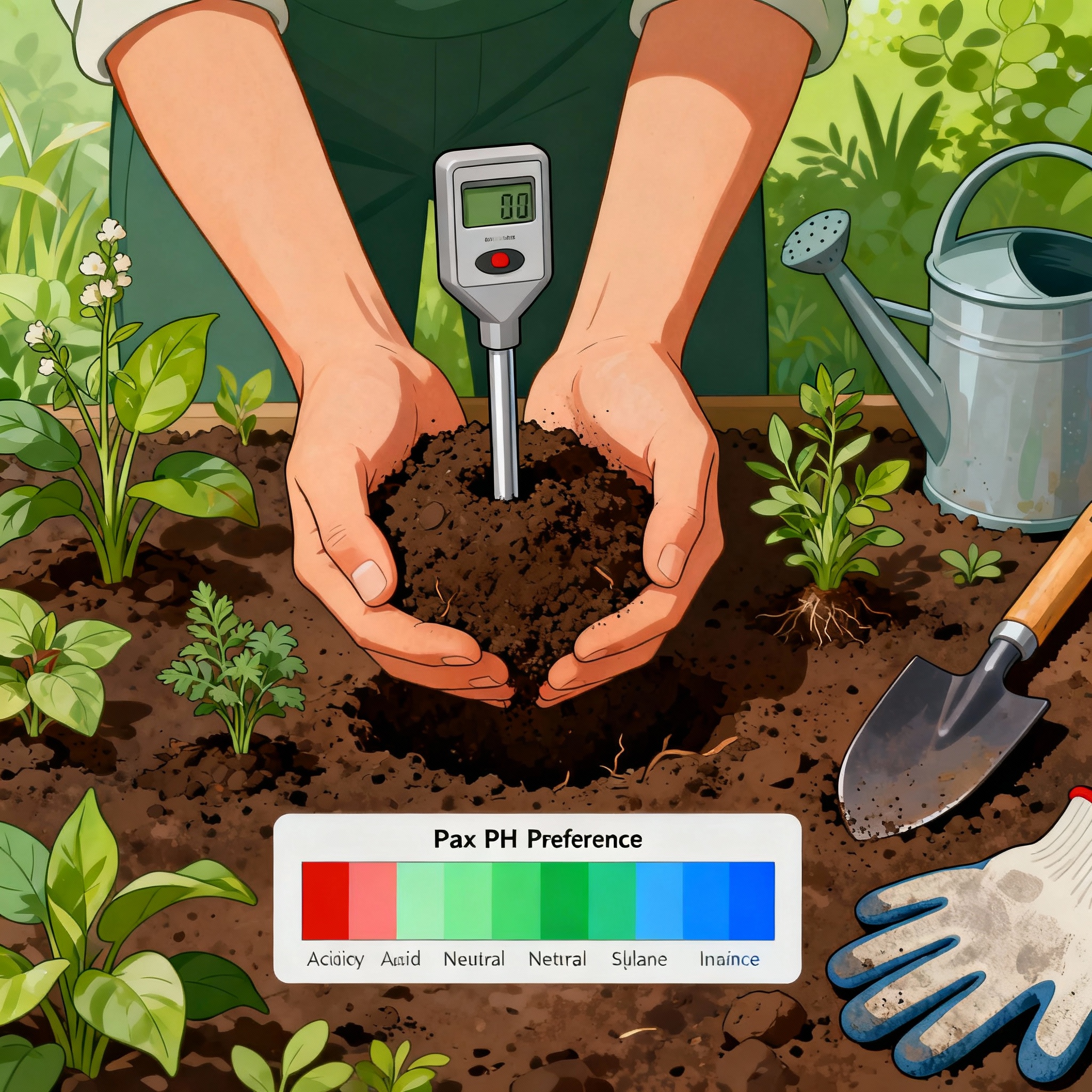Soil pH Adjustment Calculator
Plant pH Preferences
🥬 Vegetables (6.0-7.0)
Optimal pH: Slightly acidic to neutral
- Tomatoes: 6.0-6.8
- Peppers: 6.0-7.0
- Lettuce: 6.0-7.0
- Carrots: 5.5-7.0
- Beans: 6.0-7.0
- Cucumbers: 6.0-7.0
🫐 Acid-Loving Plants (4.5-5.5)
Optimal pH: Acidic
- Blueberries: 4.5-5.5
- Azaleas: 4.5-5.5
- Rhododendrons: 4.5-5.5
- Potatoes: 5.0-6.0
- Strawberries: 5.5-6.5
- Cranberries: 4.0-5.0
🌿 Herbs (6.0-7.5)
Optimal pH: Neutral to slightly alkaline
- Basil: 6.0-7.5
- Parsley: 6.0-7.0
- Oregano: 6.0-8.0
- Thyme: 6.0-8.0
- Rosemary: 6.0-7.5
- Sage: 6.0-7.0
🌹 Flowers (6.0-7.0)
Optimal pH: Slightly acidic to neutral
- Roses: 6.0-6.5
- Marigolds: 6.0-7.5
- Sunflowers: 6.0-7.5
- Zinnias: 5.5-7.5
- Petunias: 6.0-7.0
- Dahlias: 6.5-7.0
🥦 Brassicas (6.0-7.5)
Optimal pH: Neutral to slightly alkaline
- Broccoli: 6.0-7.0
- Cabbage: 6.0-7.5
- Cauliflower: 6.0-7.0
- Kale: 6.0-7.5
- Brussels Sprouts: 6.0-7.5
🌳 Trees & Shrubs
Optimal pH: Varies by species
- Apple trees: 6.0-7.0
- Oak trees: 6.0-7.0
- Hydrangeas: 5.5-6.5 (blue)
- Hydrangeas: 6.0-6.5 (pink)
- Lavender: 6.5-7.5
Soil pH Reference Guide
pH Scale (0-14)
Very Acidic
Acidic
Neutral
Alkaline
📊 Understanding pH
What is pH?
pH measures soil acidity/alkalinity on a 0-14 scale. pH 7 is neutral. Below 7 is acidic, above 7 is alkaline.
Why it matters:
- Affects nutrient availability
- Influences plant health
- Impacts soil microorganisms
- Controls disease susceptibility
🧪 Testing Soil pH
Methods:
- Test strips: Quick, inexpensive ($5-15)
- Digital meter: Accurate, reusable ($20-50)
- Lab test: Most accurate ($15-30)
Best practices:
- Test in spring before planting
- Sample from multiple spots
- Test every 2-3 years
- Avoid recently fertilized areas
⬆️ Raising pH (Add Lime)
When to use: Soil too acidic
Materials:
- Limestone: Most common
- Dolomitic lime: Adds magnesium
- Wood ash: Quick, use sparingly
Application:
- Apply in fall for spring planting
- Takes 3-6 months to work
- Mix thoroughly into soil
⬇️ Lowering pH (Add Sulfur)
When to use: Soil too alkaline
Materials:
- Elemental sulfur: Long-lasting
- Aluminum sulfate: Fast-acting
- Peat moss: Gradual, organic
- Compost: Mild, slow
Application:
- Sulfur takes 6-12 months
- Aluminum sulfate works quickly
- Apply evenly, water well
📏 Application Rates
To Raise pH 1 Point:
- Sandy soil: 25 lbs lime/1000 sq ft
- Loamy soil: 50 lbs lime/1000 sq ft
- Clay soil: 75 lbs lime/1000 sq ft
To Lower pH 1 Point:
- Sandy soil: 10 lbs sulfur/1000 sq ft
- Loamy soil: 15 lbs sulfur/1000 sq ft
- Clay soil: 20 lbs sulfur/1000 sq ft
⚠️ Important Tips
Safety & Best Practices:
- Change pH gradually (0.5 points per year)
- Never exceed recommended rates
- Retest soil after 6 months
- Water thoroughly after application
- Wear gloves when handling amendments
- Don’t over-lime (can lock up nutrients)
- Most plants tolerate pH 6.0-7.0
Soil pH Calculator User Guide
What It Does:
Calculate the exact amount of lime (to raise pH) or sulfur (to lower pH) needed to adjust your soil to optimal levels for healthy plant growth.
How to Use:
⚗️ Calculator Tab
- Enter Current Soil pH:
- Use a soil pH test kit
- Typical range: 4.0-8.0
- Test before amending
- Enter Target pH:
- Based on plants you’ll grow
- Most vegetables: 6.0-7.0
- Acid-loving plants: 4.5-5.5
- Alkaline-loving: 7.0-8.0
- Garden Area:
- Total area in square feet
- Area you want to amend
- Select Soil Type:
- Sandy: Light, drains quickly
- Loamy: Medium, balanced (most common)
- Clay: Heavy, drains slowly
- Calculate:
- Click “Calculate Amendment”
- Results show:
- Amendment type (lime or sulfur)
- Total pounds needed
- Number of bags
- Estimated cost
- Step-by-step instructions
🌱 Plant pH Guide Tab
Quick reference for optimal pH by plant type.
Categories:
- Vegetables (6.0-7.0): Tomatoes, peppers, lettuce, beans
- Acid-Loving (4.5-5.5): Blueberries, azaleas, potatoes
- Herbs (6.0-7.5): Basil, thyme, rosemary
- Flowers (6.0-7.0): Roses, marigolds, petunias
- Brassicas (6.0-7.5): Broccoli, cabbage, kale
- Trees & Shrubs: Varies by species
📖 pH Guide Tab
Comprehensive reference with visual pH scale and detailed information.
Sections:
- pH Scale (0-14): Visual color-coded scale
- Understanding pH: Why it matters for plants
- Testing Methods: Strips, meters, lab tests
- Raising pH: Lime types and application
- Lowering pH: Sulfur and alternatives
- Application Rates: By soil type
- Safety Tips: Best practices
Amendment Guidelines:
To Raise pH by 1 Point (Add Lime):
- Sandy soil: 25 lbs/1000 sq ft
- Loamy soil: 50 lbs/1000 sq ft
- Clay soil: 75 lbs/1000 sq ft
To Lower pH by 1 Point (Add Sulfur):
- Sandy soil: 10 lbs/1000 sq ft
- Loamy soil: 15 lbs/1000 sq ft
- Clay soil: 20 lbs/1000 sq ft
Amendment Types:
Raising pH (Acidic → Neutral):
- Limestone: Most common, slow-acting (3-6 months)
- Dolomitic lime: Adds magnesium, preferred
- Wood ash: Fast but use sparingly
- Hydrated lime: Very fast but caustic
Lowering pH (Alkaline → Acidic):
- Elemental sulfur: Long-lasting (6-12 months)
- Aluminum sulfate: Fast-acting (1-2 months)
- Peat moss: Gradual, organic
- Compost: Mild, improves soil structure
Quick Tips:
✅ Test soil annually – pH changes over time
✅ Change pH gradually – Maximum 1 point per year
✅ Apply in fall – For spring planting (lime needs time)
✅ Mix thoroughly – Work into top 6-8 inches
✅ Water after applying – Activates amendments
✅ Retest in 6 months – Verify changes
Pro Tip: Most garden plants tolerate pH 6.0-7.0. Only adjust if your soil is significantly outside this range. Extreme pH adjustments can lock up nutrients and harm beneficial soil organisms. When in doubt, improve soil with compost rather than dramatic pH changes!

Angelina Everly leads the editorial desk at Live Green Gardens, blending practical plant care, hands-on product testing, and approachable outdoor styling. She focuses on step-by-step how-tos, buyer’s guides, and small-space makeovers that work in real life and real budgets. When she’s not comparing pruning shears or setting up a drip kit, you’ll find her creating cozy corners with planters, solar lights, and pollinator-friendly picks—always with clear pros/cons and safety notes so you can buy once and garden happy.

